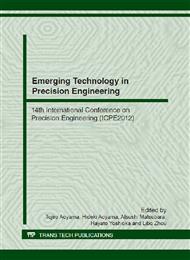p.184
p.191
p.197
p.203
p.209
p.215
p.220
p.226
p.232
Investigation of Cutting Phenomena in High Speed Ultrasonic Turning
Abstract:
This study investigated phenomena of ultrasonic cutting in case of high speed conditions. Ultrasonically assisted cutting techniques were developed by Kumabe in 1950’s. He found “critical cutting speed” that limits cutting speed to obtain ultrasonically assisted effects and is calculated by frequency and amplitude of oscillation. In general, ultrasonically assisted cutting is not suitable for high speed cutting conditions because the effects of ultrasonically applying are canceled due to tool contacts with workpiece during cutting operation. Present ultrasonically assisted cutting cannot increase cutting speed because cutting speed is limited by above reason. And ultrasonically assisted cutting cannot improve productivity due to long processing time. We conducted high speed ultrasonic cutting, maximum cutting speed of this research was 160m/min which is higher than general critical cutting speed. Workpiece material is JIS SUS304 stainless steed and cemented carbide tool inserts were employed in this research. In ordinary cutting, generate terrible built up edge on to tool rake face. In case of low amplitude ultrasonic cutting, tool rake face hasn’t built up edge and periodically marks by ultrasonic oscillation were remained on the surface. Cutting phenomena of ultrasonic cutting is different compared with ordinary cutting conditions.
Info:
Periodical:
Pages:
209-214
Citation:
Online since:
November 2012
Keywords:
Price:
Сopyright:
© 2012 Trans Tech Publications Ltd. All Rights Reserved
Share:
Citation:


